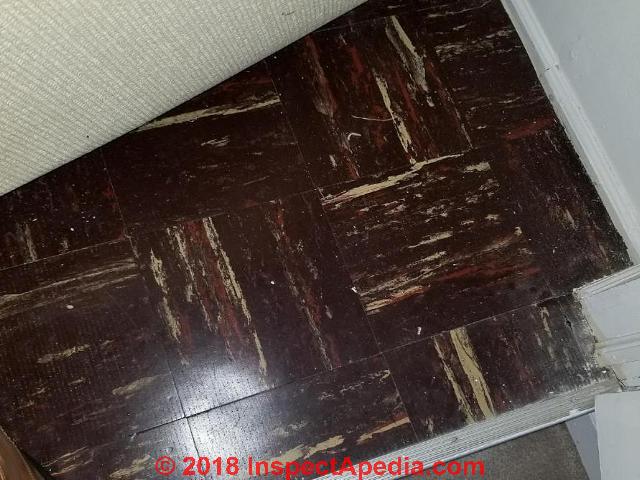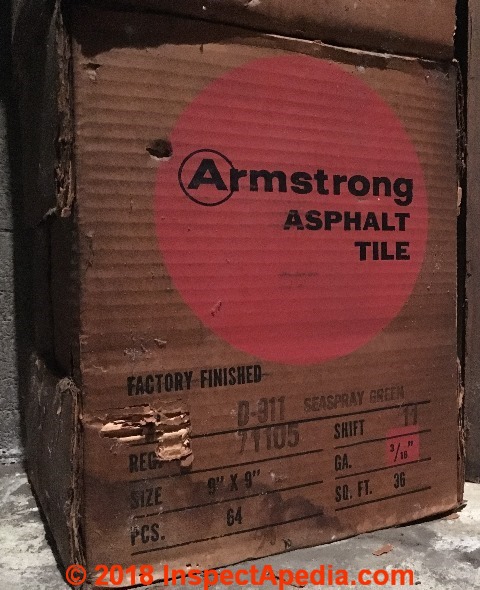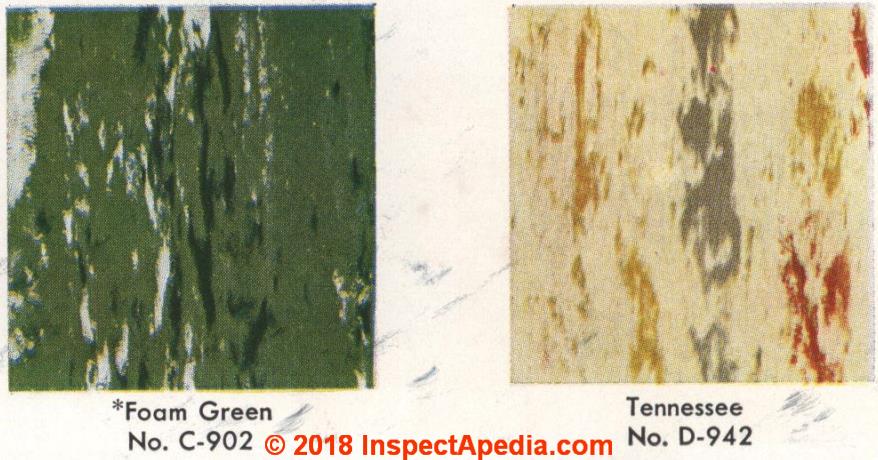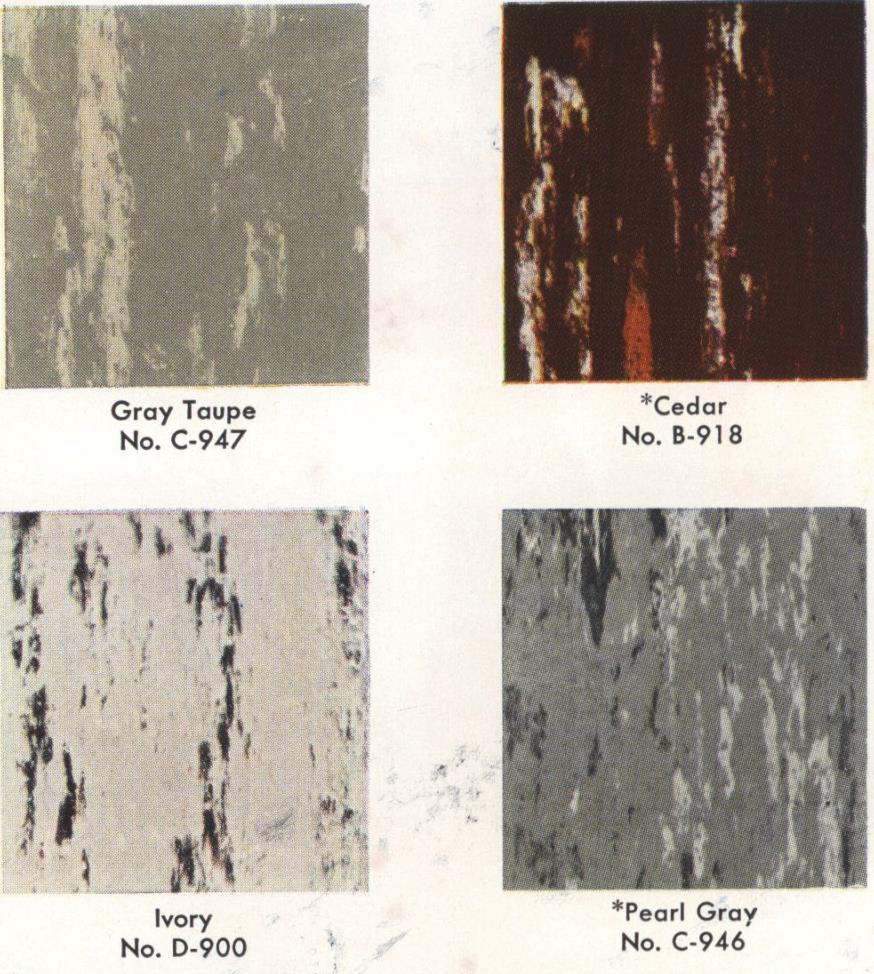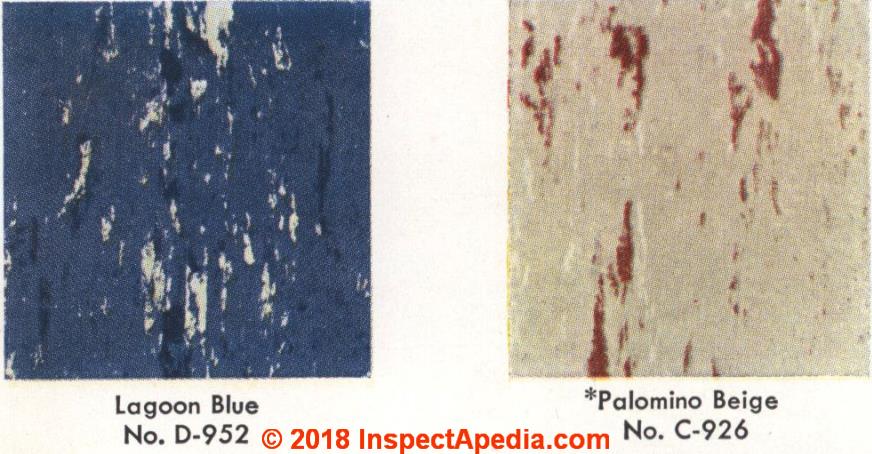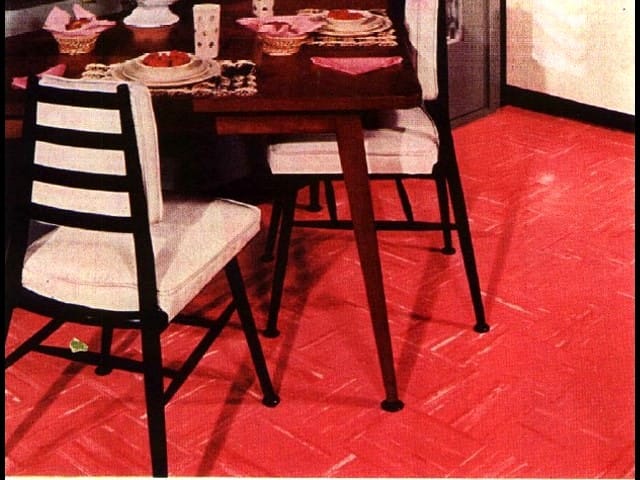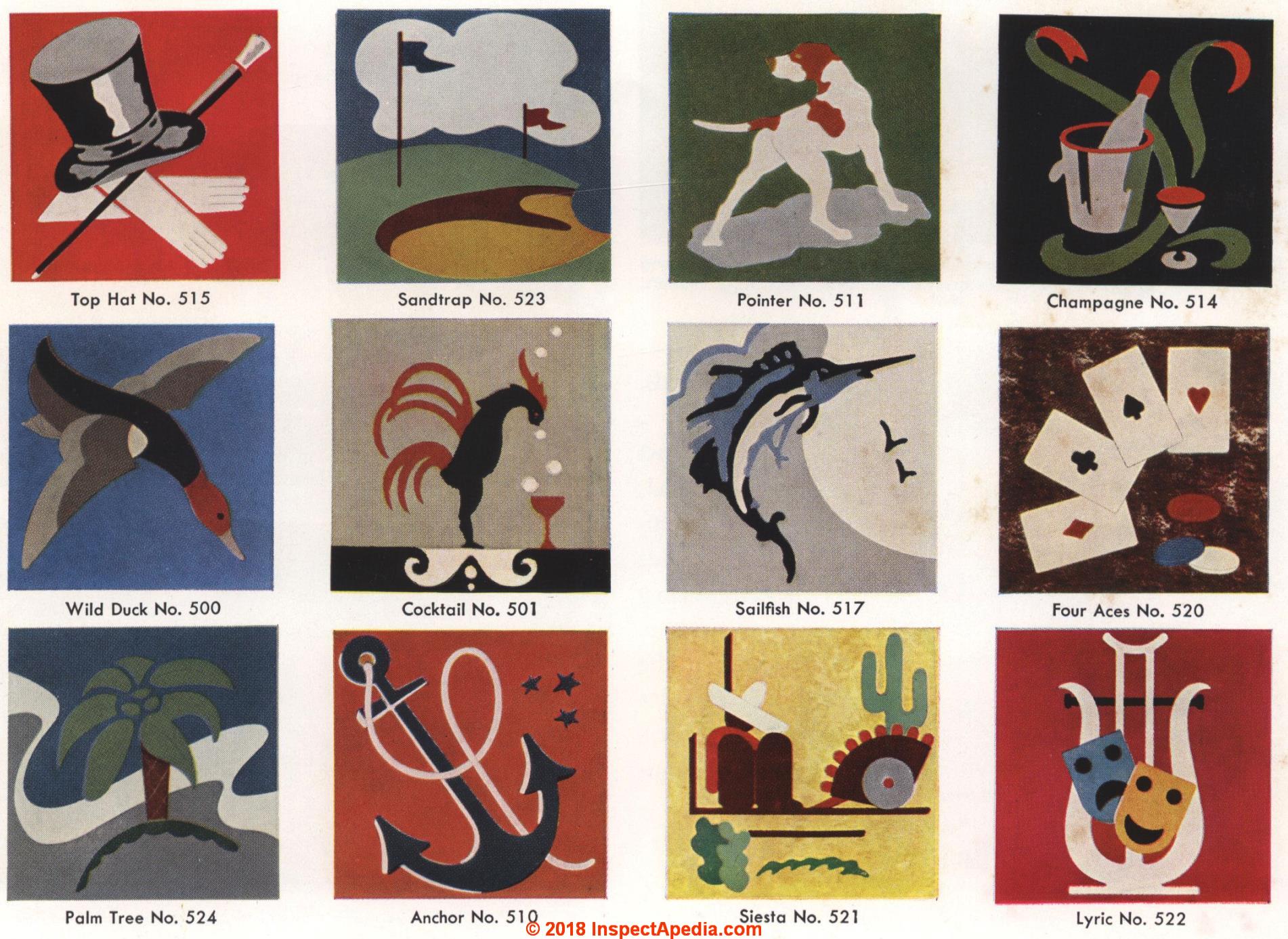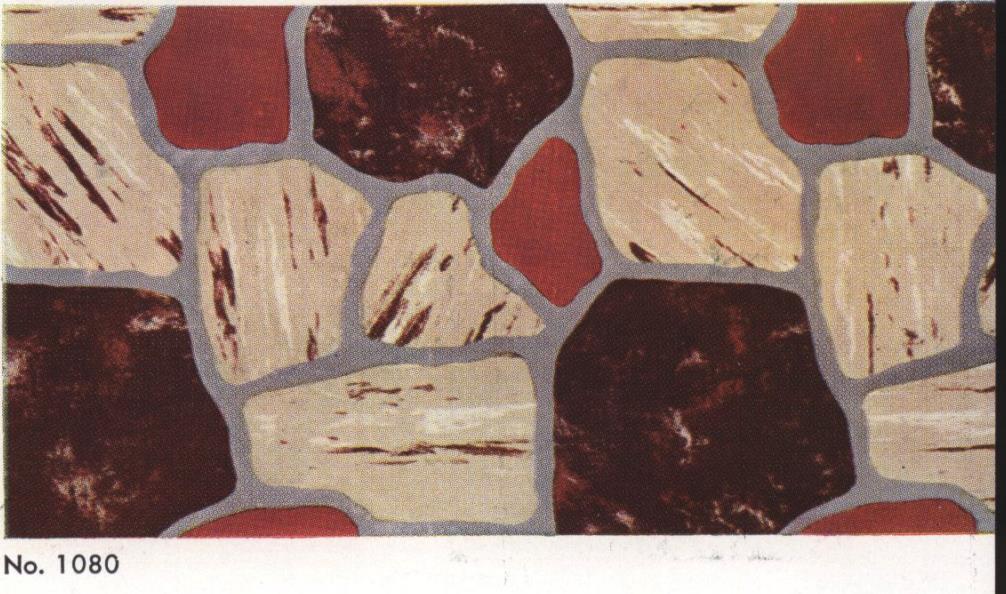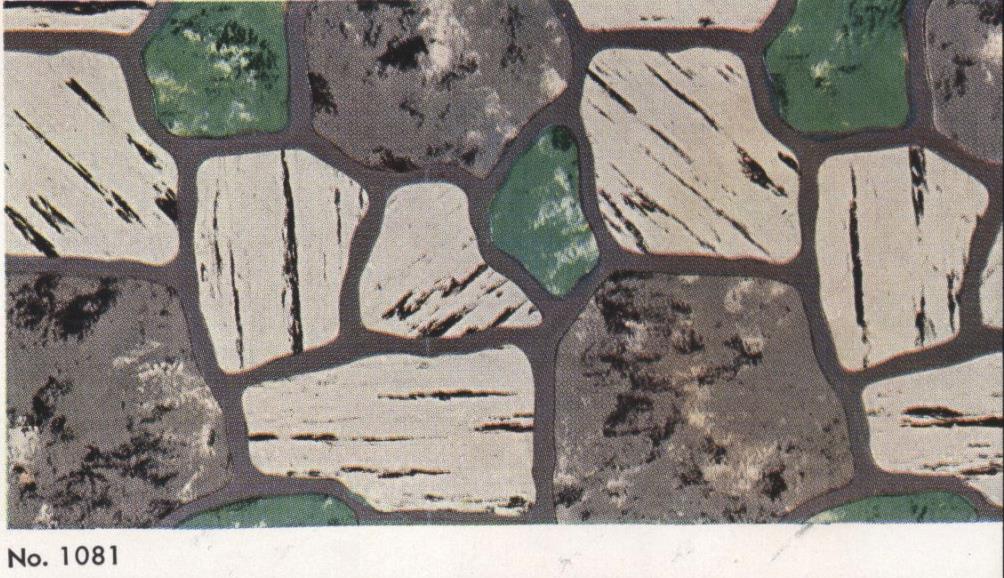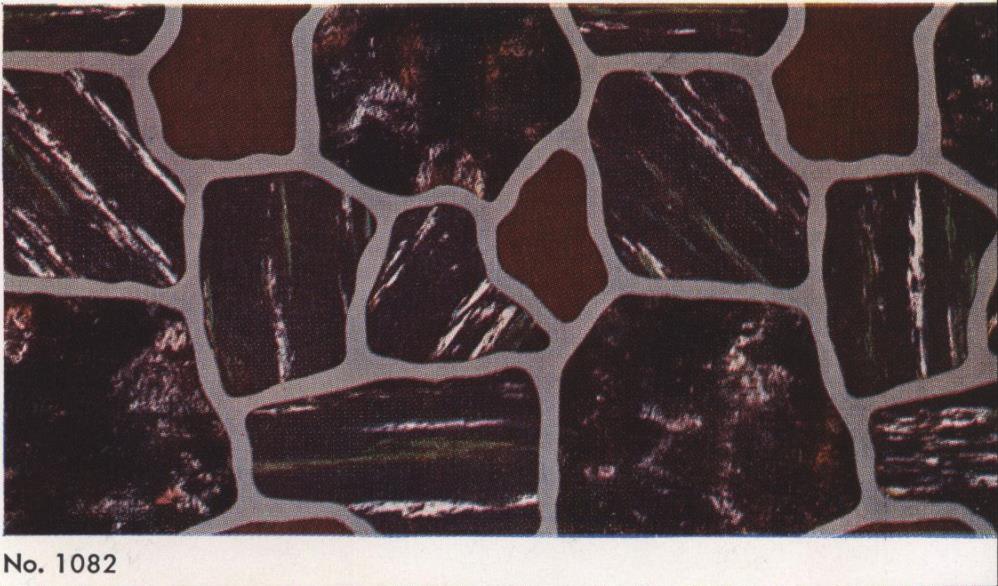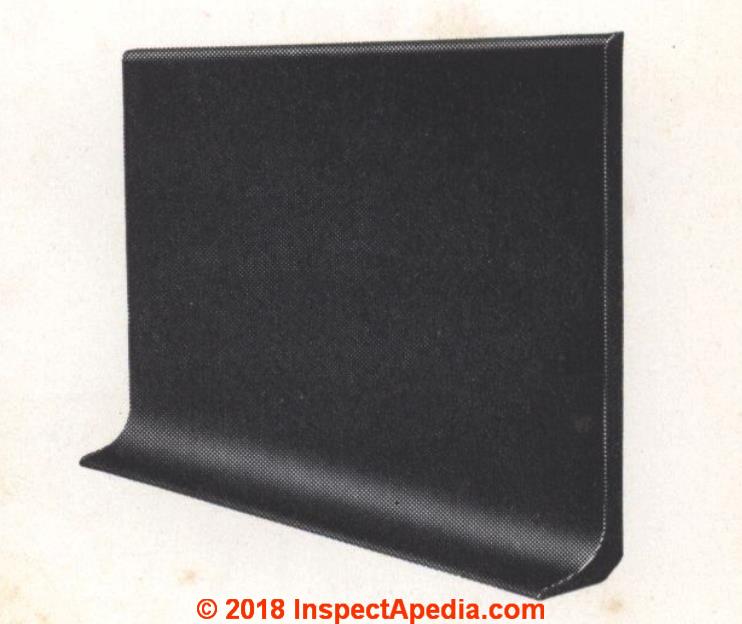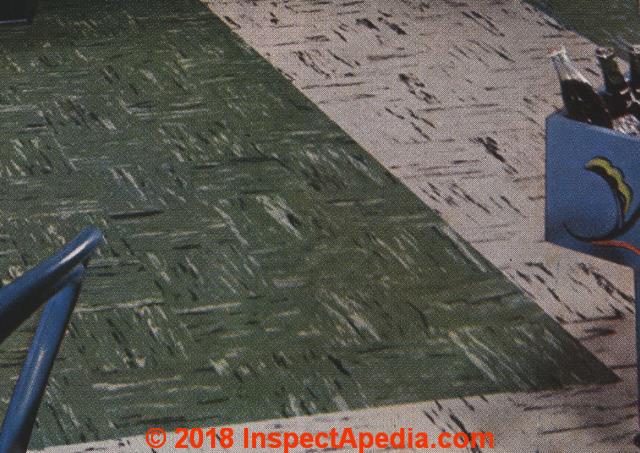 1920s-1950s Asphalt Asbestos Floor Tile Identification Key
1920s-1950s Asphalt Asbestos Floor Tile Identification Key
Armstrong & Other Brands, Floor Tile Catalogs
- POST a QUESTION or COMMENT about how to identify brands & types of asbestos-containing floor tiles
Photo guide to asphalt asbestos floor tiles sold by Armstrong in the 1930s -1950s.
These asphalt-based flooring products typically contain chrysotile asbestos, and possibly other asbestos forms.
This article series provides a guide to identifying asphalt-asbestos flooring (1917 - ca 1960) & vinyl asbestos floor tile (ca 1952 - 1986): identification photographs, product names, styles, colors, and vinyl-asbestos floor patterns, and colors for asbestos-containing floor tile products made between about 1930 and 1986 - flooring materials that are reported to or have been confirmed to contain asbestos in asbestos fiber or asbestos powder-filler form.
Page top photo: Armstrong Seaspray Green asphalt asbestos floor tiles from the 1950s.
InspectAPedia tolerates no conflicts of interest. We have no relationship with advertisers, products, or services discussed at this website.
- Daniel Friedman, Publisher/Editor/Author - See WHO ARE WE?
Identify Asphalt & Vinyl Asbestos based Floor Coverings & Floor Tiles 1900 - 1986
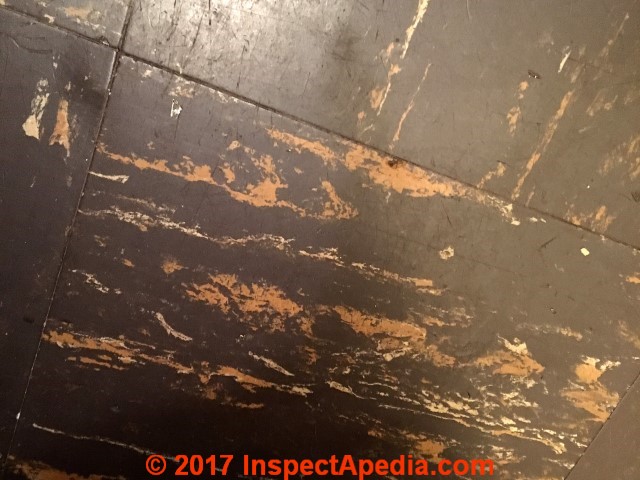
Asphalt-Asbestos resilient floor tiles Manufacturers, Brands, Styles, Photo Guide begins here.
Bottom line:
For buildings with floor tiles or sheet flooring that can be assumed to have been installed in North America before 1986, treat the floor tiles or sheet flooring as "PACM" or "Presumed Asbestos Containing Material".
For flooring made in other countries, see the regulation dates and other key dates for last use of asbestos found
at ASBESTOS MATERIAL REGULATIONS
How to Find Your Floor Tile or Sheet Flooring in this Flooring Reference Photo Guide
Asphalt asbestos and vinyl-asbestos floor tiles were produced in 9" x 9", 12" x 12", and even 18" x 18" as well as in decorative strips, and in thicknesses of 1/16", 3/32", and 1/8", also in 0.08 gauge.
Some sheet flooring or resilient flooring also contained asbestos, as did floor tile mastics.
This photo guide to asphalt asbestos & vinyl asbestos floor tiles for each year shows at least one color photo of each floor tile style or pattern in an example color.
A list below each group of photos includes the names of and links to additional photos for other colors of these styles.
The brown and marble patterned asphalt-based floor tiles shown in our photograph are almost certainly an asphalt-asbestos floor tile from the 1940's or 1950's, probably an Armstrong flooring pattern.
Asphalt-based floor tiles pre-dated vinyl-based floor tiles and were usually of much darker background colors.
Shown below are examples of vinyl-asbestos floor tiles.
Asbestos is safe and legal to remain in homes or public buildings as long as the asbestos materials are in good condition and the asbestos can not be released into the air.
Asphalt / Asbestos in Flooring - 1900 - 1930
Asphalt based flooring materials are described in quite a few U.S. patent disclosures with a surge of activity in the 1920s. A few examples are given here.
- Abraham, Herbert. Asphalts and allied substances: their occurrence, modes of production, uses in the arts and methods of testing. D. van Nostrand, 1918.
Excerpt: … A laboratory was erected to investigate the uses of this asphalt, which was marketed in France under the name “Rock asphalt mastic," and used for surfacing floors, bridges and … - Bartlett, Francis A. FIBROUS COMPOSITION of MATTER [PDF] U.S. Patent 1,598,636, issued September 7, 1926.
Excerpt:
My improved composition consists of a filler such as sawdust, wood flour or ground 2 cork, or other finely divided vegetable matter; a fiber such as asbestos, hair, or other fibrous material; a base such as Portland cement, sand or other cheap material; a preservative such as asphalt, coal tar, oil or the like; a binder preferably of water glass having the consistency of molasses; water-proofing consisting of a coating of asphalt and asbestos put on over the surface of the composition after same has hardened in the cavity; and re-enforcing consisting of iron rods, bolts, wire, rope, or other material (used only in large cavities).
The composition more or less specifically consists of sawdust. 4 to 16 parts; asbestos cment. (asmaII quan- 1 part; Porfland c tity)' as half or tar, Isutficient to thoroughly sa ura e anc coat all the particles of the filler and the fibrous material); water glass. (sufficient to make the compomplastic, sticky mass which can be worked readily but will hold its shape). - Hannam, George C., and Julius W. Schede. FLOORING TILE [PDF] U.S. Patent 1,637,301, issued July 26, 1927.
Excerpts:
Specifically stated our improved composition is as follows: Pounds. Gilsonite asphalt 25 Vegetable pitch 25 Asbestos fiber 120 Coloring matter. . Asbestos fiber, and it is well within our invention to employ other fiber which may be found to give good results.
A tile-composition, comprising gilsonite asphalt, vegetable pitch, and asbestos fiber, in substantially the proportions of twentyfive pounds of asphalt, twenty-five pounds :of pitch, and one hundred and twenty pounds of asbestos fiber, in which mixture coloring matter is incorporated. - Hannam, George C., and Julius W. Schede. "Flooring tile." U.S. Patent 1,637,302, issued July 26, 1927.
- Loomis, Chauncey C. FLOORING [PDF] U.S. Patent 1,682,530, issued August 28, 1928.
Excerpt:
This invention relates to floors, and has for its object the provision of an improved flooring and method of laying same.
So-called mastic floors have hitherto been 5 aid by mixing a solution of bituminous material in an organic solvent such as naphtha with a suitable filler such as asbestos or fine then troweled over a wood, concrete, or steel.
The resulting paste is then troweled over a wood, concrete, or steel floor or foundation and the solvent is allowed to evaporate. Alternativey the bituminous material may be melted by appli cation of heat and the filler mixed in. - Ross, Joseph. Waterproofing engineering for engineers, architects, builders, roofers and waterproofers. John Wiley & sons, Incorporated, 1919.
Describes the history of waterproofing beginning with the Egyptians who used asphalt, perhaps mixed with an asbestos filler to waterproof the foundations of the pyramids. - Shively, R. R. "An investigation of composition flooring." Industrial & Engineering Chemistry 8, no. 8 (1916): 679-682.
Excerpt: … asbestos, and colored with different inorganic colors, is made into a “mortar” by the addition of a solution of magnesium chloride; the material is then applied to the floor … with asphalt, ... - Wager, Samuel Tobias. "The Water-Proofing of Solid Steel-Floor Railroad Bridges." Transactions of the American Society of Civil Engineers 79, no. 2 (1915): 306-335.
Excerpt: … asbestos felt with asphalt mastic instead of brick or reinforced concrete. This is probably allowable with asbestos … felt, or fabric treated with asphalt, will draw the asphalt out of the felt and …
Early Asphalt Plank Flooring - 1930s - U.S. Post Offices
Where to find antique US Post Office Plank Flooring Pattern Tiles
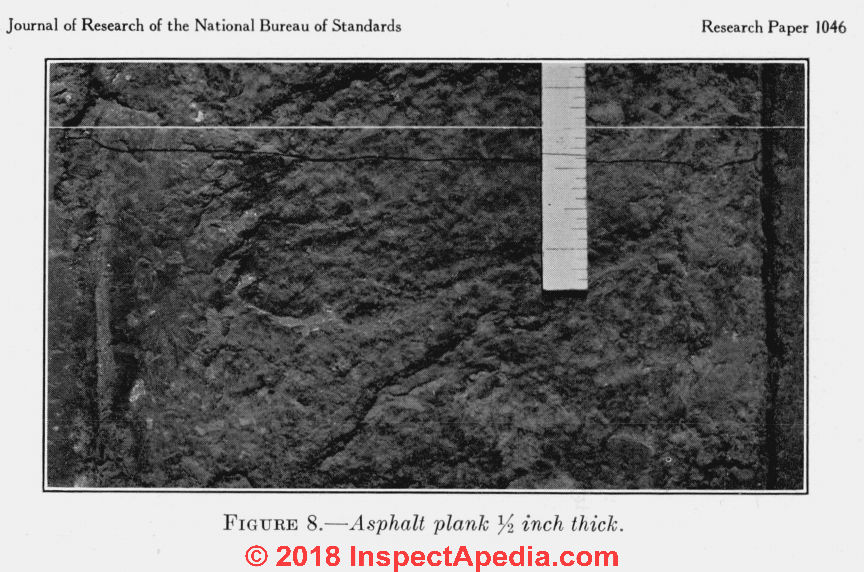 I am trying to locate a source for 12"x24"x1/2" asphalt plank flooring that was used in United States Post Office all aver the US in the sixties, seventies and eighties. - d On 2015-03-31 by gary jastad
I am trying to locate a source for 12"x24"x1/2" asphalt plank flooring that was used in United States Post Office all aver the US in the sixties, seventies and eighties. - d On 2015-03-31 by gary jastad
On 2015-03-31 by (mod) - asphalt plank flooring used in United States Post Offices 1937-1980
Gary
Black asphalt-based plank flooring was in use in U.S. post offices well before the years you give - 1960-1980 in thicknesses of about 1/2 inch.
I found research describing that flooring product in use in Post Office work rooms in 1937.
Use our CONTACT link at page bottom to find my email, send me some sharp photos, and I will research the flooring.
Asphalt plannk is not currently used in new construction (AS-503-2010)
See these research papers on asphalt plank flooring
- Emley, Warren E., Carl E. Hofer, TEST of FLOOR COVERINGS for POST-OFFICE WORKROOMS [PDF] U.S. Department of Commerce, National Bureau of Standards, Research Paper RP1047, November 1937, retrieved 2018/12/03, original source: https://nvlpubs.nist.gov/nistpubs/jres/19/jresv19n5p567_A1b.pdf
Abstract:
Twenty kinds of floor coverings were tested to learn their relative suitabilities in the workrooms of post offices.
The 20 samples included 8 of wood, 5 of concrete, 2 each of asphalt, magnesite, and rubber, and 1 of linoleum.
The test consisted in the continuous operation of t wo post-office platform trucks around a track. The trucks have steel wheels and were loaded to 1,000 and 1,500 pounds, respectively.
The results are shown by photographs taken after 60,000 passages of the truck. The results show that maple, linoleum, or perhaps rubber should give satisfactory durability in this service.
Excerpt:
Asphalt specimen 7 was made of blocks 5 by 12 by 2 inches set in }f inch of mortar.
Specimen 8 was asphalt plank, }f inch thick. The surfaces of both block and plank roughened quite readily under this treatment, and for this reason they could not be kept clean by sweep ing.
The plank showed considerably more wear than the block. - HANDBOOK AS-503, STANDARD DESIGN [PDF] June 17, 2010 Chapter 2 - Architectural [PDF] APWU, American Postal Workers Union, AFL-CIO, retrieved 2018/12/03, original source: https://www.apwu.org/sites/apwu/files/resource-files/AS-503%20Standard%20Design%20Criteria%2006-10%20%283.65%20MB%29.pdf
Excerpt: Use of asphalt plank is no longer allowed in new construction.
Armstrong & Other Brannds of Asphalt Asbestos Flooring Sold in the 1940s
Below: this floor, found in a U.S. home builty in 1947, is probably Armstrong Asphalt Asbestos Cedar No. B-918. However you will also see similar flooring by Kentile - for which we include a link just below.
Thanks to reader anonymous, 2018/08/09.
This floor was in remarkably good-condition, has been left in place, and by the current home owner, is kept covered by carpeting.
Below, courtesy of the same reader, we see a spatter-pattern floor tile typicaly sold by Kentile and some other manufactuers in the 1950s. Thanks to Anon. 2021/03/27
See other examples of these 1940s and 1950s floor tile patterns
at KENTILE FLOOR COLORS & PATTERNS KEY
1955 - Complete Armstrong Excelon Vinyl Plastic Asbestos Floor Tiles, Patterns & Color Guide
In 1955 Armstrong's asphalt-based floor tiles (all containing asbestos) were produced in 9" x 9" dimension and in 1/8" as well as 3/16" thicknesses. Some of these were also available in Armstrong Greaseproof Asphalt Tile.
1955 asphalt asbestsos flooring: Armstrong Excelon
Seaspray Green D-911 and
Foam Green C-092 are shown combined in this excerpt from this
ARMSTRONG 1955 ASPHALT FLOOR TILE CATALOG [PDF]
These are 9x9" floor tiles.
A typical Armstrong 9x9" floor tile packaging box with its labeling is shown below, provided by an InspectApedia.com reader. [Click to enlarge any image]
Below: Armstrong's Seneca White floor tile.
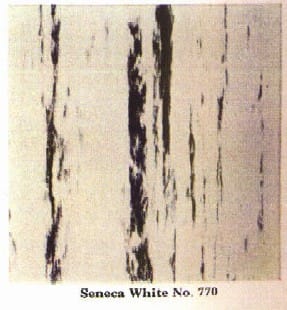
SENECA WHITE (above left), shown was a popular color.
1955 asphalt asbestos or vinyl asbestos floor tiles were sold only in 9" x 9" 1/16" or 1/8" gauge sizes, in one pattern (above) in seventeen colors. The new 1955 pattern was a change from the swirl graining pattern used in 1954. 1/16" was referred to as service gauge.
1955 Armstrong Asphalt-Asbestos Floor Tile Color List:
POMPIAN RED A-200,
BLACK A-210.
SENECA WHITE 770,
MOHAWK GRAY 771,
COMMANCHE BLACK 772,
SHAWNEE BLUE 773
SEMINOLE YELLOW 774
AZTEC GRAY 775
CHEROKEE WHITE 776,
APACHE RED 777 - first year for this long-running favorite color,
PAWNEE BEIGE 778,
MOHICAN CEDAR 779,
OSAGE GREEN 780,
NAVAHO GRAY 781,
SIOUX PINK 782,
IROQUOIS TAN 783,
IVORY D-900,
FOAM GREEN C-902, EBONY B-905, JASPER GREEN C-907,
SEASPRAY GREEN D-911,
TOKAY B-919,
CEDAR B-918,
CINNIBAR C-924,
PALOMINO BEIGE C-926, GOLDENROD D-927,
ANTIQUE GREEN B-935, AGATE B-936,
TENNESSEE D-942, PEWTER GRAY C-944,
CAMERO GRAY C-961, CORINTHIAN RED D-964, LIGHT WOODTONE D-970, DARK WOODTONE C-971
Above - probably Armstrong asphalt asbestos floor tile in pattern
and color OSAGE GREEN 780.
[Click to enlarge any image]
APACHE RED shown above as an installed vinyl asbestos floor.
NAVAJO GRAY No. 781 (above) vinyl asbestos flooring images from 1955
Armstrong Solid Color Feature Strips 1955
According to some sources we found, no solid color feature strips were sold in 1955. However solid color feature strips do appear in this
ARMSTRONG 1955 ASPHALT FLOOR TILE CATALOG [PDF]
indicating that solid color feature strips were sold in six colors in 1", 2" and 3" widths. Feature strip asphalt flooring were usually installed to form a border around the room or to mark off a rug area.
Armstrong Die Cut Insert Tiles 1955
In 1955 the Armstrong company also sold die-cut asphalt tile inserts in 12 patterns including Top Hat No. 515, Sandtrap No. 523, Pointer No. 511, Champagne No. 514,
Wild Duck No. 500, Cocktail No. 501, Sailfish No. 517, Four Aces No. 520,
Palm Tree No. 524, Anchor No. 510, Siesta No. 521, Lyric No. 522.
See also KENTILE DIE CUT & THEME FLOOR TILES
Armstrong Flagstone Pattern Asphalt Tile 1955
Also appearing in 1955 was Armstrong's Flagstone pattern asphalt tile, sold in three color patterns (below), in 18" wide strips designed to fit into typical 18" wide mortar beds, and described as
"... especially appropriate for ranch-type houses, enclosed porches, and open plan living areas. It's suitable for installation in basements too."
Armstrong Asphalt Cove Base
In 1955 Armstrong also sold an asphalt-based cove base used to trim the wall/floor juncture.
Early Asphalt Asbestos Flooring Researcy + Armstrong 1955 Asphalt Asbestos Floor Tile Catalog
- ARMSTRONG 1955 ASPHALT FLOOR TILE CATALOG [PDF] that was digitized by the Association for Preservation Technology (apti.org) and cataloged in the U.S. archives retrieved 2018/02/07, original source: ia600402.us.archive.org/2/items/ArmstongAsphaltTile1958/Armstong%20Asphalt%20Tile%201958.PDF These are 9x9" floor tiles.
- Levin, Harold L. WATERPROOF FIBROUS PRODUCT [PDF] U.S. Patent 1,785,357, issued December 16, 1930.
Excerpt: In another run, where an asbestos product was desired, the stock was composed of 20 to 25 parts of low grade asbestos fibre, parts of asphalt dispersion containing about 50% asphalt, and 40 to 45 parts of mineral fines in the form of an impalpable asbestos dust. To this stock was added the necessary amount of precipitating agents such as sodium silicate and alum, as above described. - NEO, ASBESTOS FACT SHEET [PDF] Nebraska Department of Energy, Email: energy@nebraska.gov, retrieved 2023/05/03, original source: https://neo.ne.gov/programs/wx/wx-fact-sheets/asbestos-fact-sheet.pdf
- Rankin, Albert I. COMPOSITE COATING MATERIAL [PDF] U.S. Patent 1,778,727, issued October 21, 1930.
Excerpts: This invention relates to composite coat iug materials having an asphaltic or bituminous … upon floors and other surfaces which have been levelled and smoothed as well as upon floors …
For the filler I may use ground stone, slate, slag, cinders, clay, asbestos, etc. or any of the other suitable ground materials commonly employed as fillers in paints and molded products, and the proportion of filler to the bituminous or other base and cementing material may be from 1 part of filler to 1 part of cementing base in the richest mixtures to 10 parts of filler to l of cementing base in the leanest mixtures.
...
Continue reading at ASBESTOS FLOOR TILE IDENTIFICATION PHOTOS 1956-1957 or select a topic from the closely-related articles below, or see the complete ARTICLE INDEX.
Or see these
Recommended Articles
- ASBESTOS TEST RESULTS for TILE & SHEET FLOORING - confirmation by lab tests or documents
- ASBESTOS FLOOR TILE PHOTO ID GUIDE - home
- ASBESTOS FLOOR TILE IDENTIFICATION COLOR KEY - home
- ASBESTOS FLOORING HAZARD REDUCTION
- ASBESTOS FLOORING IDENTIFICATION
- ASBESTOS FLOORING IDENTIFICATION GUIDE INDEX - all brands, all years
- ASBESTOS FLOORING REMOVAL GUIDE
- ASBESTOS REMOVAL, WETTING GUIDELINES
- ASBESTOS RISK ASSESSMENT
- ASBESTOS TEST RESULTS for TILE & SHEET FLOORING
- ASBESTOS TESTING LAB LIST
- DOES THIS FLOOR CONTAIN ASBESTOS? - 5 easy questions to tell if your FLOOR probably contains asbestos -
- DOES THIS MATERIAL CONTAIN ASBESTOS? - 5 easy questions to tell if a BUILDING MATERIAL probably contains asbestos -
- MARBLE / STONE CHIP PATTERN FLOORING ASBESTOS
- RESILIENT SHEET FLOORING ID GUIDE
Suggested citation for this web page
ASBESTOS FLOOR TILE IDENTIFICATION PHOTOS 1900 -1950s at InspectApedia.com - online encyclopedia of building & environmental inspection, testing, diagnosis, repair, & problem prevention advice.
Or see this
INDEX to RELATED ARTICLES: ARTICLE INDEX to ASBESTOS HAZARDS
Or use the SEARCH BOX found below to Ask a Question or Search InspectApedia
Ask a Question or Search InspectApedia
Try the search box just below, or if you prefer, post a question or comment in the Comments box below and we will respond promptly.
Search the InspectApedia website
Note: appearance of your Comment below may be delayed: if your comment contains an image, photograph, web link, or text that looks to the software as if it might be a web link, your posting will appear after it has been approved by a moderator. Apologies for the delay.
Only one image can be added per comment but you can post as many comments, and therefore images, as you like.
You will not receive a notification when a response to your question has been posted.
Please bookmark this page to make it easy for you to check back for our response.
IF above you see "Comment Form is loading comments..." then COMMENT BOX - countable.ca / bawkbox.com IS NOT WORKING.
In any case you are welcome to send an email directly to us at InspectApedia.com at editor@inspectApedia.com
We'll reply to you directly. Please help us help you by noting, in your email, the URL of the InspectApedia page where you wanted to comment.
Citations & References
In addition to any citations in the article above, a full list is available on request.
- [1] Armstrong ® Residential Flooring - Website 05/15/2010 https://www.armstrongflooring.com/ lists current flooring products provided by the Armstrong Corporation, including Armstrong's current vinyl floor tile products at https://www.armstrongflooring.com/flooring/products/vinyl-floors
- [2] Armstrong Corporation, Corporate History - https://www.armstrongflooring.com/corporate/corporate-history.html - Web Search 05/19/2010
- [3] Armstrong vinyl asbestos floor tiles: photos of asbestos-vinyl floor tiles as catalog pages (PDF form) are at www.asbestosresource.com/asbestos/tile.html
- [6] "Asbestos Floor Tile Removal", the University of Minnesota's advice on removing VAT (vinyl asbestos or asphalt asbestos floor tile) can be read in detail at www.health.state.mn.us/divs/eh/asbestos/floortile/index.html
- [8] Resilient Floor Covering Institute, 1030 15th St. NW, suite 350, Washington D.C.
- [9] Inspiring Interiors from Armstrong 1950s from Armstrong, [Paperback], Schiffer Publishing (March 1998), ISBN-10: 0764304585, ISBN-13: 978-0764304583
- [1] Interior Solutions from Armstrong the 1960s from Armstrong, [Paperback], Schiffer Publishing (March 1999), ISBN-10: 0764307002, ISBN-13: 978-0764307003
- [11] Asbestos products and their history and use in various building materials such as asphalt and vinyl flooring includes discussion which draws on ASBESTOS, ITS INDUSTRIAL APPLICATIONS, ROSATO 1959, D.V. Rosato, engineering consultant, Newton, MA, Reinhold Publishing, 1959 Library of Congress Catalog Card No.: 59-12535 (out of print).
- [12] Congoleum Corporation, "Company History", Congoleum Corporation, Department C, P.O. Box 3127, Mercerville, NJ 08619-0127 1-609-584-3601, web-search 03/14/2011, original source: http://www.congoleum.com/history.html
- [14] EPA Guidance for Controlling Asbestos-Containing Materials in buildings, NIAST, National Institute on Abatement Sciences & Technology, [republishing EPA public documents] 1985 ed., Exposure Evaluation Division, Office of Toxic Substances, Office of Pesticides and Toxic Substances, U.S. Environmental Protection Agency, Washington,D.C. 20460
- [18] "Plastic Flooring Spreads Through the House", Jackson Hand, Guide to Home-Improvement Materials, Popular Science, April 1969, p. 154-158
- [25] L.R. provided photographs of Armstrong Palimino Beige and Pecan Beige asphalt asbestos floor tiles, floor tile packaging and identification details, along with asbestos test lab results. Personal correspondence with DF, 10/22/2012
- [26] Window Putty - OSHA case cites contractor for asbestos exposure during removal of window putty http://www.osha.gov/pls/oshaweb/owadisp.show_document?p_table=NEWS_RELEASES&p_id=1091 June 1997 -
- [28] Stanton, .F., et al., National Bureau of Standards Special Publication 506: 143-151
- [20] Pott, F., Staub-Reinhalf Luft 38, 486-490 (1978) cited by McCrone
- Asbestos products and their history and use in various building materials such as asphalt and vinyl flooring includes discussion which draws on ASBESTOS, ITS INDUSTRIAL APPLICATIONS, ROSATO 1959, D.V. Rosato, engineering consultant, Newton, MA, Reinhold Publishing, 1959 Library of Congress Catalog Card No.: 59-12535 (out of print, text and images available at InspectAPedia.com).
- [31] "Handling Asbestos-Containing roofing material - an update", Carl Good, NRCA Associate Executive Director, Professional Roofing, February 1992, p. 38-43
- [32] EPA Guidance for Controlling Asbestos-Containing Materials in buildings, NIAST, National Institute on Abatement Sciences & Technology, [republishing EPA public documents] 1985 ed., Exposure Evaluation Division, Office of Toxic Substances, Office of Pesticides and Toxic Substances, U.S. Environmental Protection Agency, Washington,D.C. 20460
- In addition to citations & references found in this article, see the research citations given at the end of the related articles found at our suggested
CONTINUE READING or RECOMMENDED ARTICLES.
- Carson, Dunlop & Associates Ltd., 120 Carlton Street Suite 407, Toronto ON M5A 4K2. Tel: (416) 964-9415 1-800-268-7070 Email: info@carsondunlop.com. Alan Carson is a past president of ASHI, the American Society of Home Inspectors.
Thanks to Alan Carson and Bob Dunlop, for permission for InspectAPedia to use text excerpts from The HOME REFERENCE BOOK - the Encyclopedia of Homes and to use illustrations from The ILLUSTRATED HOME .
Carson Dunlop Associates provides extensive home inspection education and report writing material. In gratitude we provide links to tsome Carson Dunlop Associates products and services.


